
The Arado Ar 80 was a pre-World War II fighter aircraft, designed by Arado Flugzeugwerke to compete for the Luftwaffe's first major fighter contract. The Ar 80 was uninspiring in terms of performance and also suffered a number of failures. The contest was eventually won by the Messerschmitt Bf 109, and the Ar 80 prototypes ended their days as test aircraft.

The Arado Ar 196 is a shipboard reconnaissance low-wing monoplane aircraft designed and produced by the German aircraft manufacturer Arado. It was the standard observation floatplane of the Kriegsmarine throughout the Second World War, and was the only German seaplane to serve throughout the conflict.

The Arado Ar 68 was a single-seat biplane fighter designed and produced by the German aircraft manufacturer Arado Flugzeugwerke. It was among the first fighters produced when Germany abandoned the restrictions of the Treaty of Versailles and began rearming.
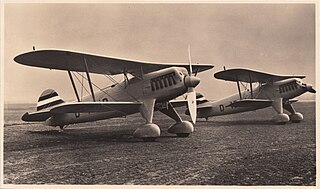
The Heinkel He 51 was a German single-seat biplane fighter aircraft. A seaplane variant and a ground-attack version were also developed. It was a development of the earlier He 49.

The Heinkel He 114 was a sesquiplane reconnaissance seaplane produced for the Kriegsmarine in the 1930s for use from warships. It replaced the company's He 60, but it did not remain in service long before being replaced by the Arado Ar 196, Germany's standard observation seaplane.

The Arado Ar 65 was the single-seat biplane fighter successor to the Ar 64. Both looked very similar. The only major difference was the use of a 12-cylinder inline engine versus the Ar 64's radial. The wingspan was also increased.
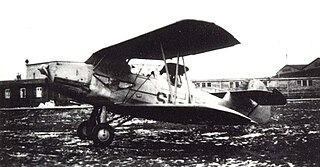
The Arado Ar 66 was a single-engined twin-seat training biplane designed and produced by the German aircraft manufacturer Arado. It was the last aircraft to be designed by the aeronautical engineer Walter Rethel in collaboration with Arado.

The Heinkel He 59 was a twin-engined German biplane designed in 1930, resulting from a requirement for a torpedo bomber and reconnaissance aircraft able to operate on wheeled landing gear or twin-floats.

The Arado Ar 197 was a German World War II-era biplane, designed for naval operations for the never-completed German aircraft carrier Graf Zeppelin. Only a few prototypes were built; the project was abandoned in favour of the Messerschmitt Bf 109T and Me 155.

The Arado Ar 95 was a single-engine reconnaissance and patrol biplane designed and produced by the German aircraft manufacturer Arado.

The Arado Ar 76 was a German aircraft of the 1930s, designed as a light fighter with a secondary role as an advanced trainer in mind.

The Arado S I was a biplane trainer built in Germany in 1925. The first of three prototypes was powered by a Bristol Lucifer radial engine, while the other two Arado S.Ia aircraft were fitted with the Siemens-Halske Sh 12. The Siemens-Halske Sh 11 powered the Arado S III, a virtually identical aircraft of which only a single prototype was constructed and sold to Turkey.
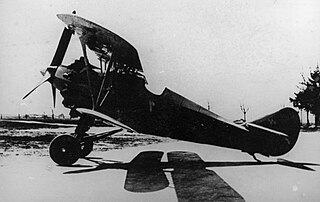
The Arado SD II was a fighter biplane developed in Germany in the 1920s. Like the preceding SD I, it was intended to equip the clandestine air force that Germany was assembling at Lipetsk and was hoped to overcome the shortcomings of that type. Although it shared the same basic configuration, the SD II was an all-new design. A considerably larger and heavier aircraft, it had wings of less stagger, braced with conventional wires. The landing gear and tailplane were of far stronger construction.
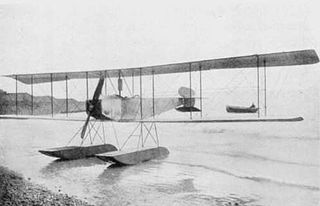
The Avro Type H, Type 501, and Type 503 were a family of early British military seaplanes. They were a development of the Avro 500 design and were originally conceived of as amphibious, the prototype being fitted with a single large main float under the fuselage, and two outrigger floats under the wings.

The Heinkel HD 42 50, later designated the Heinkel He 42 was a German two-seat biplane seaplane originally designed for the Deutsche Verkehrsfliegerschule, and later built for the German Luftwaffe. The aircraft was used until the end of World War II as a trainer for maritime pilots.
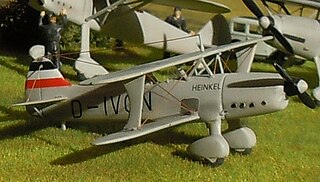
The Heinkel He 74 was a light fighter aircraft developed in Germany in the early 1930s. It was a conventional, single-bay biplane with staggered, unequal-span wings braced with an I-type interplane strut. The pilot sat in an open cockpit, and the undercarriage was of the fixed, tailskid type.
The Heinkel HD 26 was a reconnaissance seaplane developed in Germany during the 1920s for production in Japan. It was intended as a smaller, single-seat counterpart to the HD 25, to provide a spotter aircraft for warships and to take off from a short ramp. The HD 26 was a conventional biplane with staggered wings, twin float undercarriage, and an open cockpit.
The Heinkel Doppeldecker 43 was a prototype German fighter aircraft of the 1930s. A single-engined, single-seat biplane, the HD 43 was designed to meet a secret German Reichswehr requirement for a single-seat fighter. It had two-bay wooden wings with a steel-tube fuselage, and was powered by a 750 hp (600 kW) BMW VI engine. The single prototype flew in 1931.

The Focke-Wulf Fw 62 was a reconnaissance floatplane, designed and built by Focke-Wulf for use by Nazi Germany's Kriegsmarine. Only four were built.

The Arado Ar 81 was a German prototype dive bomber. Because the Reich Air Ministry decided to purchase the competing Junkers Ju 87, only three prototypes of the Ar 81 were completed.


















